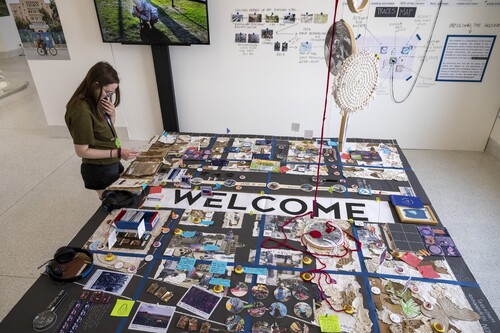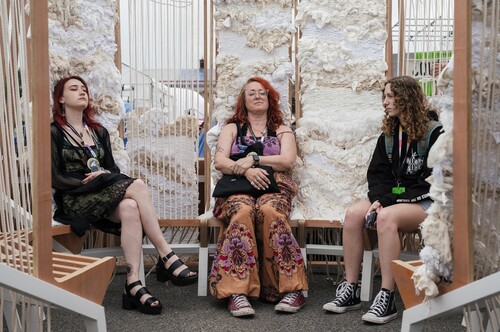ABSTRACT
The Performance Space Exhibition at the 2023 Prague Quadrennial (PQ) – titled ‘Acts of Assembly’ – explored how theatres and performance spaces operate as sites of assembly and spaces for community. It asked: How do they create connections? How do they facilitate encounters? How do they function as sites for social action and the making of culture? Focussing on the dynamics of different acts of assembly, and positing performance itself as an assemblage, the exhibition explored the productive continuities and antagonisms between more traditional theatre architectures and the broader emergent qualities of performance spaces. This essay reflects on how the exhibition expressed a vision of performance spaces as a vital social infrastructure. It suggests the concept of social infrastructure as a useful analytic for examining how performance spaces support and sustain people and practices. The essay also reflects on the unsettled positioning of theatre architecture and performance space within PQ more generally.
Introduction
As curator of the Performance Space Exhibition my aim was to create a forum for considering how performance spaces operate as sites for assembly and community.Footnote1 Additionally I sought to attend to the uncommon spaces and practices in which we might glimpse future possibilities for performance space and through which we might respond meaningfully to the social, political and ecological challenges we face. The Performance Space Exhibition expressed a vision of performance spaces as a vital social infrastructure, mediating connections and associations. In this essay I reflect on the exhibition and suggest the concept of social infrastructure as a useful analytic for thinking through how performance spaces support and sustain assemblies. I also reflect on the increasingly unsettled positioning of architecture within the Prague Quadrennial (PQ). As scenography and performance design have expanded to take on an active role in the authoring of social space, and PQ has embraced performance and transformed into a festival, the presence of architecture has become more unsettled and more distributed across the PQ programme.
Acts of assembly
My curatorial concept for the Performance Space Exhibition proposed an examination of performance space through the lens of assembly. Calling the exhibition ‘Acts of Assembly’, I posited performance spaces as active assemblages of bodies, materials, and technologies. Through this I sought to open up the exhibition to a wide range of potential venues and spaces, and to acknowledge that theatres and performance spaces not only facilitate assembly but are themselves spatially and materially performative. The act of assembling or gathering is fundamental to theatre, and so assembly also served as a means of exploring the continuities and antagonisms between more traditional theatre architecture and the broader emergent qualities of performance spaces.
The COVID-19 pandemic provided a catalyst for reconsidering theatrical assembly and was a key factor in developing the concept for the exhibition. The closure of theatres and performance spaces in the face of public health restrictions during the pandemic called into question their existence as physical sites of gathering and revealed traditional auditoria as ill-suited to adaptation in response to what was an ecological as well as a public health crisis. The response of theatre and performance makers to the pandemic was the widespread adoption of event streaming and digital media as platforms for performance. Experimental forms of performance – particularly mobile, intermedial and installation-based forms – also offered ways of working with the presence of the virus and public health requirements for social distancing. The disruption of the everyday machinery of theatrical production prompted a profound questioning of the status quo for theatrical production, inspiring initiatives which addressed precarious working conditions, structural inequalities in theatre, and ecologically sustainable production practices (see Filmer et al. Citation2020). In this context the question of what performance space might be and how it functions as a site of assembly seemed timely and present.
My awareness of the broader critical and artistic interest in public assemblies and their material forms and supports was also a factor in developing the concept for the exhibition. The term assembly denotes the gathering of a group or crowd of people, as well as the putting together or construction of an object or piece of machinery, and the gathering of a deliberative or decision-making body. These overlapping meanings draw our attention to the actions of bodies in any gathering, to the material sources of support they draw on, and to the forms and procedures for collective life and decision-making that they employ. Political assemblies have become a globally recognised feature of social movements in the twenty-first century, from the uprisings of the Arab Spring to the Occupy movement and the Nuit Debout in France, among others (Davidian and Jeanpierre Citation2023). In her theorising of the performative dimensions of such assemblies, Judith Butler (Citation2015) sees their reworking and reconfiguring of public space as not just the assertion of a people’s right to collective appearance, but also as an enactment of their desire to bring into actuality the social forms they seek. While focussed on the actions of massed bodies, Butler also acknowledges the infrastructure that supports them. Such support takes the form of locations and architectures, material and technical infrastructures, and conventions and ways of working. An interest in support and co-ordination across art and performance is an important dimension of the wider performative and social turns in art practice, as examined in Céline Condorelli, Gavin Wade and James Langdon’s Support Structures (Citation2009) and Shannon Jackson’s Social Works (Citation2011). Jonas Staal (Citation2017) has proposed a practice of ‘assemblism’ which might work through social movements and support the development of new collectivities, and Florian Malzacher (Citation2023) has identified assembly as a crucial concept and practice in political theatre, which draws on theatre’s strength as a concrete place of gathering and a form which simultaneously deploys the real and the fictional (Citation2023, 113). This variety of critical and artistic concern with forms of assembly and infrastructural support responds to the undermining of collectivity and interdependence through economic exploitation, precarity and ecological breakdown. These are ‘crisis times’, observes Lauren Berlant, where ‘politics is defined by a collectively held sense that a glitch has appeared in the reproduction of life’ (Citation2022, 24).
In the open call for submissions to the exhibition I posed three questions which asked potential contributors to reflect on the functions of their performance spaces as sites of assembly. I asked: How do they create connections? How do they facilitate encounters? How do they function as spaces for social action and the making of culture? Running through these questions is a concern with how spaces mediate assembly and afford sociality. Submissions were invited in the form of a portfolio of material traces which might provide insight into the specific qualities of the space being exhibited: its textures, its atmospheres, its actions, and its operations. These traces could include one or more of the following: a short film; a sound recording; an object or thing; an architectural fragment; or a visual image. Submissions to the exhibition took on a wide range of forms. Half were submitted as films, but alongside these were still photographs, installations, models, and interactive experiences, including a mobile theatre – The Drifting Room – which traversed the streets outside the gallery. Comprising 35 exhibits sourced from 26 different countries, the exhibition was located on Level 5 of the National Gallery’s Trade Fair Palace (Veletržní Palác). In contrast to the Holešovice Market, the main venue for PQ 2023, the Trade Fair Gallery’s modernist white box aesthetic and gallery atmosphere offered a quieter space for contemplation and conversation. Included were examples of newly built theatres and performance arts centres, renovations of existing theatres, and adaptations of found spaces. A number of contributions to the exhibition evidenced responses to the COVID-19 pandemic. There were interventions into public spaces, spaces of encounter with the more-than-human world, sites for communal celebration and reflection, and venues that facilitate cultural exchange and access. The possibilities of digital platforms and technologies were addressed through spatial audio, extended reality, and hybrid virtual–physical spaces.Footnote2
An additional curatorial aim was to increase the representation of global majority countries, cultures, and peoples, including spaces that might embody the knowledges and cultures of First Nations peoples. I had some limited success in increasing the level of inclusion of performance spaces from Africa, with projects submitted from Ghana, Rwanda, South Africa, and Uganda. All of these were submitted as short films. Only one submission – a film from PACT Centre for Emerging Artists in Australia – offered a direct First Nations perspective. The structural limitations on participation in PQ – particularly lack of access to financial support and the difficulties of securing visas for entry into the European Union – profoundly affect who can participate in PQ and the form that any participation takes.
Social infrastructure
The diversity of spaces, situations and contexts included in the exhibition highlighted the infrastructural role of performance spaces in supporting and mediating assembly and expressed a vision of performance spaces as a social infrastructure. Social infrastructure typically refers to the built infrastructures, public spaces, and organisations which facilitate social interaction. The sociologist Eric Klinenberg defines social infrastructure as ‘the physical places and organizations that shape the way people interact with each other in everyday life’ (Citation2018, 5). Although broad, Klinenberg’s definition has been influential because it identifies that collective public life is actively supported by spaces, sites and institutions. In the category of social infrastructure Klinenberg includes public and private spaces and organisations including schools, community centres, libraries, parks, sidewalks, places of worship, community organisations, and businesses like barbershops and cafes.
Social infrastructure plays a role in combating isolation, promoting inclusion, strengthening social cohesion, and enhancing the liveability of cities and neighbourhoods. A common feature of social infrastructures is that they are open to appropriation, allowing for encounters between diverse individuals and groups (Campbell et al. Citation2022, 715). Geographers Alan Latham and Jack Layton (Citation2022) identify social infrastructures as sites of collective capacity which support ‘a robust public collective life’ (662–3). But they also argue that the concept needs further analytical development to better articulate the nuances and textures of sociality and how they are afforded by the specifics of spaces (Layton and Latham Citation2022). Sarah Hall (Citation2020) and Amy Horton and Joe Penny (Citation2023) argue for the need to recognise the gendered and racialised labour required to support and maintain social infrastructure and the power relations and differentials inherent in the provision of social infrastructure (Citation2023, 2). Their perspectives align social infrastructure with social reproduction and suggest that analysis of social infrastructure attend to people, relationships, and labour, not just spaces. AbdouMaliq Simone’s concept of ‘people as infrastructure’ focusses on the conjunctions between people in situations of precarity and infrastructural failure, and Simone argues that such conjunctions ‘become an infrastructure – a platform for reproducing life in the city’ (Citation2004, 407). Developing his concept through fieldwork in Johannesburg, Simone argues that the actions of bodies, particularly in developing nations, constitute ‘a dynamic infrastructure’; through applying the term infrastructure to people he reframes collective life as itself a technical accomplishment (Simone Citation2021, 1343).
Social infrastructure offers a useful analytic for understanding performance spaces and how they support and sustain people and practices. But theatres and performance spaces are largely absent from existing discourses on social infrastructure. Considering performance spaces as social infrastructures can help to articulate and identify their vital contribution to sociality. Performance spaces mediate collective living and the generation and renewal of associations via affective experience (see Read Citation2008). Performance spaces also operate as spaces of openness and the making of culture where broader issues and experiences can be engaged with through staging situations which mix the physical and the fictional. Ngugi wa Thiong’o (Citation1997) locates the politics of performance space in its openness, an openness he sets against the repressive confinement of the state. For Thiong’o, performance spaces are sites of political openness where the internal forces of the stage and the external forces and relations of wider social space are actively negotiated in the context of time and history (14). This open quality allows for the material play of performance, the generation of affect, and the encouragement of agency, which Alan Read argues is central to theatre’s social role (Read Citation2008, 70).
As an analytic concept, social infrastructure enables an attention to performance space which is focussed on what connects and sustains people and practices. Thinking of performance spaces in infrastructural terms encourages us to continue loosening our grasp on the seeming certainties of objects and structures and instead work with what connects and sustains. Alongside more established concepts of event-space or dramaturgy, infrastructure enables a critical attention to what sustains and connects people, materials, and practices through time. In the exhibition the different spaces included expressed a vision of performance space as social infrastructure through how they created connections, how they facilitated encounters and how they operated as spaces for social action and the making of culture.
Creating connections
Common to many performance spaces in the exhibition was a tactical responsiveness to situation and circumstance as a means of generating social associations between people and practices. Performance spaces and their designers and users sought to create and strengthen connections and aid accessibility through choices of site, through flexibility, through sensory attunement, and through the blurring of boundaries.
Mhlanguli George’s Theatre in the Backyard, from Makhanda, Eastern Cape, South Africa, uses suburban backyards as performance spaces. Motivated by a desire to decolonise theatre and to reclaim stories and communal storytelling traditions, George uses backyards as sites which are already embedded in the lives of the communities he seeks to connect with. As performance space, the backyard connects stories with domestic life and hospitality, re-connecting theatre with communities. The Haduwa Apata, near Accra on the coast of Ghana, mediates between existing indigenous performance traditions and the desire to develop new forms of transdisciplinary cultural practice. The Haduwa Apata is a large, curved bamboo structure covered in white tarpaulin which serves as an open stage and performance space for the Haduwa Arts and Culture Institute. ‘Apata’ means simply ‘shed’ or ‘shelter’ in the local language, Akan, and the structure’s spatial openness and location adjacent to the beach connects performance with the environment, welcoming appropriation by local fishermen and other residents.
In Topoľčany, Slovakia, Nástupište 1-12 (‘Platform 1-12’) is a flexible art and performance space located in a pedestrian underpass which connects with its surroundings through its tactical appropriation of existing public transport infrastructure. The space operates interdependently with the underpass; large wall panels can be opened up and moved to form different spatial configurations for performances, workshops, gigs and exhibitions. French scenographer Raymond Sarti’s 200-seat modular and energy-autonomous MobilTéat (‘Mobile Theatre’) is also designed to be re-configured and re-arranged in each new location it visits. Sarti exhibited a model of the theatre suspended within his installation Facing the World: An Art of Relationship, situating it as part of his ongoing scenographic exploration of landscape. The theatre is intended to re-locate across the island of Réunion and to assemble relations with the surrounding landscape in each new location (see ).
Figure 1. A model of Raymond Sarti’s (France) MobilTé at (‘Mobile Theatre’) suspended within the installation. Photo by Anna Benhakova; Prague Quadrennial 2023.
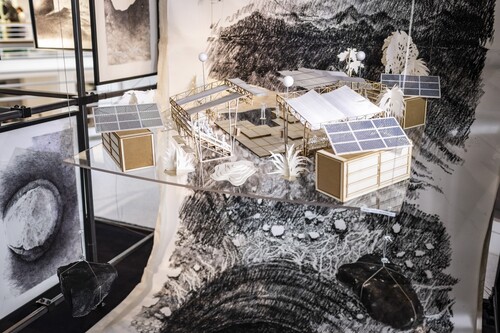
The digital installations What we Want to Hear and Digital Παγκάκια [Benches] were performance spaces that functioned as infrastructures for social attunement via listening. What we Want to Hear is a virtual audio stage in which located audio supplied via headphones encourages listeners to move and explore within a delineated physical space; the binaural audio is therefore juxtaposed with the qualities of the space. Digital Παγκάκια [Benches] was originally staged as a public art intervention in Athens using public benches. Through the use of QR codes and smartphones, Digital Παγκάκια [Benches] turns public benches into sites for recording and listening to stories.
Three exhibited projects involved the renovation of existing theatre spaces to reconnect them to evolving urban contexts. Here the re-imagining of exterior spaces, foyers and facades creates new avenues for access and association. Acts of Re-Assembly: The Re-Build of La Mama Theatre used video, photographs, a model, and objects which documented the process of re-building the iconic La Mama theatre in Melbourne, Australia, after it was devastated by fire in 2018. The presence of a large charred beam (see ) and fused melted metal worked as material reminders of loss and destruction. The challenge of re-building La Mama was to maintain the intimacy, idiosyncrasy and texture of the original double-storey nineteenth-century building but also to discover new performance possibilities across the site and re-connect it more directly to the street. Architectural firm Haworth Tompkins’ model and accompanying film documented the renovation of the Malmö Stadsteater, demonstrating how the historic circus building has been re-oriented to the city; new windows, a reconfigured foyer and better circulation have enabled greater connection to the city. The film Colours of Country by Alia Ardon is an extended meditation on a mural project which has reimagined the exterior of PACT Centre for Emerging Artists in Sydney, Australia. PACT commissioned indigenous artists Maddison Gibbs and Jason Wing (‘MadWings’) to paint the mural Heal Country as a reimagining of the exterior surfaces of their theatre, a former mechanics’ workshop. The mural’s patterns and colours generate new associations with indigenous art, knowledge, and community and the mural works as a gesture of cultural repair and healing.
Figure 2. A partial view of Acts of Reassembly: The Re-build of La Mama Theatre (Australia) showing the charred beam which now sits in the garden of the re-built theatre. Photo by Anna Benhakova; Prague Quadrennial 2023.
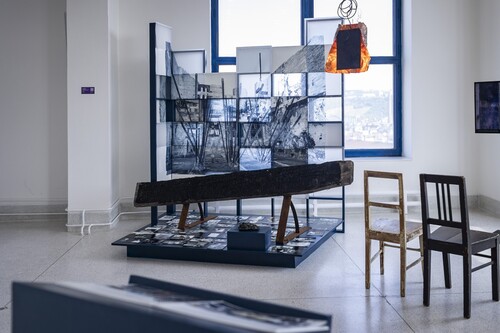
The new Taipei Performing Arts Centre (TPAC), designed by Office for Metropolitan Architecture (OMA) and opened in July 2022 after 10 years of construction, expresses the tensions of a project that seeks to negotiate contradictory urban imaginaries. TPAC’s formal appearance embodies OMA’s embrace of urban complexity and desire to integrate the venue with the life of the city. The venue’s theatres are positioned above ground level on pylons, with the space beneath available for events and public circulation. A dedicated public route – the so-called ‘Publicloooooop’ – also allows selected views of backstage and production areas. TPAC’s design embodies many of the key contemporary trends in theatre architecture: a desire to integrate structures with their environment, to encourage porosity and public engagement, and to employ flexible configurations. But while OMA sought to integrate the theatre complex with the existing Shilin Night Market, this sat at odds with the city authority’s vision of an iconic building hosting global performance events (Goudsmit, Kaika and Verloo Citation2023). The result is a theatre that sits uneasily in its urban context, somewhere between iconic object and infrastructure.
Facilitating encounters
The way performance spaces facilitate encounters was explored in a number of projects in the exhibition. As social infrastructure, performance spaces support the development of our shared perceptual capacities, our ability to perceive and comprehend the world around us in its actuality and in its possibility. Stephen Bain’s The Drifting Room reveals this dynamic through operating as a mobile theatre and spatial performance which reframes and subverts the spectacle of the global city and enables an imaginative play between what is and what could be. It uses the image of the theatre as an urban institution and deploys this to critique and reimagine the city. The Drifting Room was displayed as an object in the exhibition (), but was also experienced through performances Bain offered on the streets outside the gallery (). Participants carry the light wooden structure through the streets, led in silence by Bain’s gestures. Those inside can see out through the mesh fabric that covers it, but those outside cannot see in. The Drifting Room is a playful parodic gesture, a nomadic theatre with legs, but it also demonstrates how performance space facilitates encounters through delineating a shared space for play.
Figure 3. The Drifting Room, by Stephen Bain (New Zealand), in the exhibition space. Photo by Jakub Cervenka; Prague Quadrennial 2023.
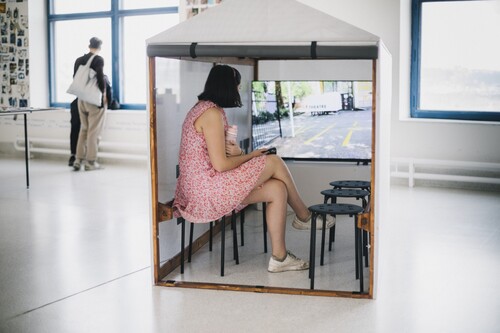
Figure 4. The Drifting Room, by Stephen Bain (New Zealand), travelling outside the gallery. Photo by Anna Benhakova; Prague Quadrennial 2023.
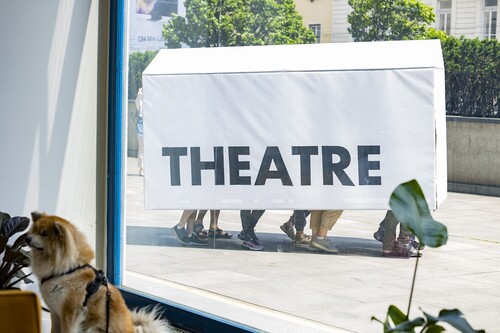
Digital technologies and platforms, and the protocols and standards that enable their systematisation, are no longer simply disruptors of our engagement with the physical world, but mediators of our life in that world. One cluster of projects in the exhibition demonstrated the potentials of digital and hybrid platforms but, collectively, revealed the entanglement of digital performance platforms and technologies with materials and physical spaces. Here such platforms and technologies mediated encounters with materiality, fragmentation, and alterity. Assemble, by Suzon Fuks, was an installation of computer components, supplied by Czech e-waste firm ASEKOL, alongside deconstructed devices and examples of miniature sculptural ‘galaxies’ of components. A projected video juxtaposing her body travelling and scrambling through these galaxies explored the relationship between the body and digital technologies, obsolescence, and the life cycle of devices. Fuks was present in her installation daily, guiding visitors to carefully take apart devices like computer hard drives and manipulate their components (). Almost adjacent to Assemble was Shattering Boundaries: A Virtual–Physical Space Interaction – a playful evocation of a hybrid performance space, with green screen, camera feeds and models – and This space is for you / cet espace est pour toi – a site-responsive mixed reality installation. In Shattering Boundaries visitors could play with hybrid spatiality by interacting with and adjusting the composite mix of different media feeds and fragments. This space is for you / cet espace est pour toi used mixed-reality technology to interrupt socially normative relationships between bodies and environments and re-orient visitors to the circulating atmospheres of the gallery itself. It did this by offering visitors a 15-minute virtual journey through a three-dimensional digital model of the gallery, re-working it in the process as a site of alterity.
Figure 5. Suzon Fuks (Australia) and participants taking computer hard drives apart. Photo by David Kumermann; Prague Quadrennial 2023.
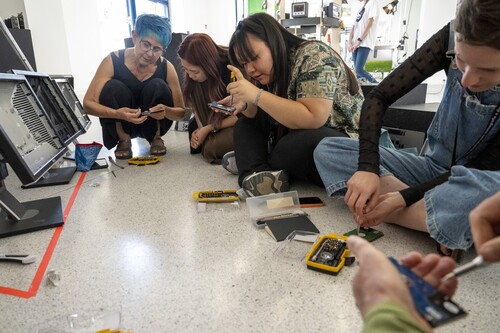
The Ubumunti Arts Festival provided a striking example of how performance spaces facilitate encounters with history and memory. The festival uses the 1200-capacity amphitheatre in the Kigali Genocide Memorial as its venue. The Genocide Memorial is a mass grave for 250,000 Tutsi murdered during the 1994 Genocide and it serves as a focal point for public mourning and education. The Ubumuntu Festival begins at the conclusion of an annual mourning period of 100 days, and repurposes the site as one which imagines a future of shared humanity through artistic performances from around the world. The installation Fragments, Pigments and Figments, curated by Ella Evangelou and Nihal Soğanci, invited visitors to undertake a simulated walk through the Ledra Palace section of the United Nations Buffer Zone in Nicosia, Cyprus. The installation comprised 14 large-format photographic images paired with 14 haiku poems from Cyprus-based artists which were placed on columns that line the gallery space. The Ledra Palace Crossing re-opened in 2003, and since 2011 has been the site for the Home for Cooperation, and the Buffer Fringe Festival since 2014. In the disputed liminal zone between northern and southern Cyprus, participation in art and performance is enabling identity negotiations which work with the particular status and spatiality of the buffer zone.
Spaces for social action and the making of culture
The function of performance spaces as spaces of openness, facilitating action and cultural production, was explored in a number of exhibited spaces. In these the dynamic tensions between past and present, between different groups, and between reality and fiction enabled performance spaces to serve as supports for social action and cultural production. Marc Rees and Jenny Hall’s AGORA was a temporary pavilion, set within the grounds of the 2019 Eisteddfod Genedlaethol (‘National Eisteddfod’) in the Welsh town of Llanwrst. The Eisteddfod Genedlaethol is Europe’s largest cultural festival and travels to a different location in Wales each year. AGORA was both a pavilion and a performance programme which evoked Llanwrst’s historical connection to Welsh independence. The structure offered a contemporary reimagining of a medieval Welsh royal court, clad in repainted doors donated by the local community and supporting a programme of performance, musical concerts and discussions. As infrastructure, AGORA was heterotopic, a space for reimagining and reinventing Welsh independence during the seven days of the Eisteddfod.
The film The Club at the Edge of Town provided insights into the site-specific theatre company Slung Low’s management of The Holbeck (Britain’s oldest Workingmen’s Club, located in Leeds) during the COVID-19 pandemic.Footnote3 The company took over the management of the club in 2019 with plans to stabilise its finances and use it as a theatre venue, but the imposition of a nationwide lockdown forced them to close it in early 2020. Slung Low were then asked by the local authority to manage social care referrals for residents in the Holbeck and Beeston area of Leeds. Reinventing themselves as a logistics hub for food and support, they expanded their remit of community cultural provision to include direct emergency support and sustenance, framing it as an expanded act of storytelling: ‘We talk often about how the foodbank was actually a piece of storytelling’, wrote artistic director David Lane, ‘the story was that no one in Holbeck and Beeston would go hungry during the Covid crisis and the easiest way to tell the story was to make it real’ (Lane Citation2022, 176).
Two further projects focussed on the methods they use to generate performance space, rather than the specifics of the spaces they generate. Here the focus was on ‘active’ rather than ‘object’ forms of social infrastructure, where design is focussed on providing instructions ‘for an interplay between variables’ rather than for a discrete object (Easterling Citation2014, 80). TAAT art collective’s The Lively Assemble was a composite offering of small sculptural installations and two videos. The sculptures invited visitors to perform small gestures of interdependence with more-than-human counterparts. The videos documented TAAT’s online collaborative platform, the Live Agora, and a recent experiment in creating an Encounter Portal, a co-created installation using biological materials. Filip Jovanovski and Ivana Vaseva’s City as a Stage: Methodology for Reading Buildings was a table-top exposition of their theatrical methodology for reading buildings. Grounded in the post-socialist socio-spatial context of Skopje, North Macedonia, the method seeks to protect modernist architectural heritage through generating new communities of interest. The Lively Assemble and City as a Stage operate with a distinct infrastructural logic, the former focussed on expanding a sense of the collective to include more-than-human entities, and the latter seeking to generate communal action to re-invigorate the social legacies of socialist-era modernist buildings.
Proyecto Tejidos [‘Fabric Project’] and A Pedra de Abalar are projects that work with material entanglement and more-than-human agencies, expanding our sense of the social beyond the human. Proyecto Tejidos () documented a series of eco-scenographic interventions into The Sullivan Garden of Art in Mexico City, staged with a regenerative intent. Four different interventions have sought to develop ways of addressing the socio-political and environmental problems that affect the garden and its inhabitants. A Pedra de Abalar presented video, a photographic image and a map to represent the overlapping temporalities and realities of the swinging stone located at Mugia, Spain. It testified to how the stone has activated people and imaginaries, generating a distinct place of meeting.
Performing architecture at PQ 2023
The vision of performance spaces as social infrastructure I have traced through the 2023 Performance Space Exhibition continues a trend evident at previous editions of PQ where the theatre building as an architectural object, and the stage as a discrete geometric space, have been displaced by the distribution of performance through wider landscapes and the unfolding of spatio-temporal relationships (Weinstein Citation2012; Arx Citation2016). The change of name in 2008 from ‘The Prague Quadrennial International Exhibition of Stage Design and Theatre Architecture’ to ‘The Prague Quadrennial of Performance Design and Space’ clearly signified this transformative shift, while the more gradual change in name of the ‘Architecture Section’ (a continuous part of PQ from its first edition in 1967) to its current title of ‘Performance Space Exhibition’ has reflected the growing embrace of an expanded vision of space. The shift to ‘performance space’ better reflects the diversity of sites, settings, and environments in which performative events now take place, but the form and focus of this section has continued to shift from one PQ to the next. This raises a question about how and where architecture is positioned at PQ. Indeed, the presence of architecture at PQ might be best described as profoundly unsettled, with the focus having shifted to the performativity of space and the encounters between performance and architecture.
At PQ 2023, architecture was performed, and was performing, across the PQ programme, evident in the PQ’s engagement with particular sites and structures, but more clearly visible in the sites of engagement offered to visitors by different installations. The Holešovice Market, the main location for PQ, and the National Gallery’s Trade Fair Palace both provided grounds for an engagement with the architecture of site, the former implicating PQ in an existing urban fabric, affording juxtaposition and surprising encounters; the latter offering volume and scale, especially for performances in its Malá Dvorana (Small Hall). But various installations, especially those in the Student Exhibition, worked consciously with a spatial dramaturgy which was architectural, inviting visitors to enter and occupy them, putting them to varied uses while also contributing to their activation in a meaningful sense. While this could be regarded as a gamification of visitors’ experiences, I view this more as an embrace of visitors’ creative agency and co-authorship of spatial situations in a way which is analogous to that offered in experiences of architecture.
The Student Exhibition at PQ 2023 was located outside in a large square of the Holešovice Market. Without pre-existing shelter and exposed to the extremes of June weather in Prague, the exhibition manifested a range of ‘scenographic’ or ‘fast’ architectural responses (Hann Citation2018).Footnote4 The most effective were those which articulated sites of engagement that were architectural in their attention to situation, shelter, and use, offering invitations to enter, occupy and use the installations. For instance, Asylum, from Poland, offered water, tea and food on a portable table, above which was tethered a large inflatable white balloon. The balloon floated on the breeze as a precarious shelter. This scenographic architecture positioned visitors in a situation reminiscent of temporary aid stations serving Ukrainian refugees. Close by, The Raft, from Belgium, was conceived as an emergency theatre and micro state. A scaffolding tower with naval iconography, it referenced temporary autonomous zones and served as a platform for a programme of events and a site for exploration and play. HODO: The Resting Assembly, from Portugal, offered a space for rest, rhetorically positioned as a space for ‘in-activism’ (see ). In contrast to the ‘great acceleration’ in resource extraction which has exacerbated our global climate crisis, the Resting Assembly was a space of deceleration and patient labour. Forming an open circle, the Resting Assembly gradually changed through a durational act of weaving and invited visitors to stop and rest. What is architectural here is the invitation to enter the work and make use of it – to occupy it or to be occupied by it.
Puzzles, from Lebanon, and We Do Not Own the Water, from France, offered an orientation towards architectural materials and associations. Puzzles evoked the urban breakdown of Beirut through its unsteady mechanic assemblage of locally sourced timber, metallic objects and rope, set alongside short texts. Here the viewer, in occupying the work and activating it, was occupied with it, generating the ephemerality of a city in a state of breakdown. We Do Not Own the Water offered a focussed meditation on stone, water and porosity within a framework of scaffolding. My abiding experience of this work was its tactility and the way the feel of stone revealed the water emerging through it, wetting my fingers.
Within the Exhibition of Countries and regions, located indoors, architecture was evoked through the relations that were established between spectators and installations, as well as through the use of building materials, fragments and forms. The maquettes in Spectators in a Ghost City (Cyprus) were resonant objects that incorporated architectural materials and had a clear architectonic form. They also articulated distinct relations with viewers, inviting them to imaginatively inhabit the structures, while also situating viewers as observed subjects through relayed CCTV footage. Limbo Hardware (Czech Republic) used re-purposed architectural fragments to create a series of parallel possible worlds, presented via a series of adjacent narrow corridors. These invited imaginative entry but also partially resisted it; the corridors could be entered, but their narrowness severely restricted movement. CROP (Catalonia) staged an archaeological investigation of the Teatre Nacional de Catalunya in the year 2053. Here the theatre building was evoked by mouldering piles of waste clothing, decomposing and overtaken by fungi and lichens. Visitors were supplied with magnifying glasses to investigate the biological life that was taking root amongst the clothes. In all three a strong sense of world was created through the play of scale and through a relationship with material and imagined architectures. Moonshine Piano (Serbia) was configured as a scaffold event-space, with a rolling programme of talks and events. Although a number of exhibits were configured as spaces for meeting and dialogue, Moonshine Piano had the clearest sense of a scenographic architecture constructed to stage discussion and encounter, and to enable matters of concern to be tabled.
These different sites of engagement offered to viewers in individual installations and exhibits was where the performance of architecture was most discernible at PQ 2023. Visitors were invited to make use of the spaces afforded and to appropriate them. But as scenographic practice generates ‘fast’ architectures and interventions, and artists construct their own spatial dramaturges and situations, these remain connected conceptually and materially to the ‘slower’ architecture of theatres and performance spaces. Similarly, they are frequently facilitated by buildings which support communities of practice and materially mediate links between the past and the present. Understanding the diversity of different theatre architectures and performance spaces as connected via the concept of social infrastructure enables a sense of how they together make a vital contribution to supporting and shaping social life. In this context, too, holding open a dedicated space at PQ for examining and debating theatre architecture and performance spaces in connection with this expanded range of scenographic interventions and practices is also vital, and will ensure a critical attention is given to the specifics of the contexts and venues in and through, and against which, scenography and performance design are practised.
Unsettling assemblies
The contributions to the Performance Space Exhibition at PQ 2023 provided a sense of the diversity of contemporary performance spaces and their connection to the particularities of local contexts and conditions. They also revealed an expanding social impulse: performance spaces are increasingly embedded in, and connected with, the dynamic associations that constitute social worlds. Emerging from the disruption of the COVID-19 pandemic, theatre-makers and artists have an expanding range of spatial choices in how they manifest and position performance in relation to communities and publics, and considering performance spaces as social infrastructure can help articulate how performance spaces contribute to communal living.
Amongst the diversity of scenography and performance design on display and in action at PQ 2023 was a noticeable engagement with the complexities of the contemporary world and the deployment of the critical tools and insights afforded by scenographic practice to those complexities. Considering performance spaces as social infrastructure suggests a role for performance spaces as laboratories for working out and negotiating how to live together, and how to extend our sense of any shared ‘we’ to more-than-human entities. This requires performance spaces which ‘do not condense, do not model, but rather place in a state of movement, retracing multiples stories and attempting to capture the singular feature of our relationship to the world: incommensurability, entanglement, interdependence, precarity’ (Aït-Touati Citation2020, 438).
Notes
1 My thanks go to Markéta Fantová (PQ Artistic Director), Michaela Buriánková (PQ General Manager), Pavel Kraus (PQ Programme Coordinator) and the wider PQ 2023 Team for their guidance and support in realising the exhibition.
2 At the time of writing, information on all the contributions to the Performance Space Exhibition can be accessed via the PQ website here: https://pq.cz/pq-2023-info/projects-2023/performance-space-exhibition/. The exhibition also hosted meetings and symposia by the Scenography and Theatre & Architecture Working Groups of the International Federation for Theatre Research (IFTR) and a workshop on designing theatre space by the OISTAT Architecture Commission. Two smaller roundtables with contributors offered opportunities for informal conversation.
3 The Holbeck Working Men’s Club opened in 1877. Working men’s clubs were formed in Britain during the nineteenth-century to enable working class education and recreation. (BBC News Citation2019)
4 In Beyond Scenography (2018), Rachel Hann distinguishes between the ‘slow’ architecture of the built environment and the ‘fast’ architecture performed by scenographic intervention. The former provides a sense of duration through time, the latter is disruptive, effecting a re-orienting and ‘temporal othering’ (125).
References
- Aït-Touati, Frédérique. 2020. ‘Acts of Inhabiting: Ancient and New Theaters of the World’. In Critical Zones: The Science and Politics of Landing on Earth, edited by Bruno Latour and Peter Weibel, translated by Liz Carey Libbrecht, 432–438. Cambridge: MIT Press.
- Arx, Serge von. 2016. ‘Unfolding the Public Space: Performing Space or Ephemeral Section of Architecture, PQ 2015’. Theatre and Performance Design 2 (no. 1–2): 82–94.
- BBC News. 2019. ‘Holbeck Working Men’s Club Honoured with Blue Plaque’. 12 September. https://www.bbc.com/news/uk-england-leeds-49675793.
- Berlant, Lauren. 2022. On the Inconvenience of Other People. Durham: Duke University Press.
- Butler, Judith. 2015. Notes toward a Performative Theory of Assembly. Cambridge: Harvard University Press.
- Campbell, Lindsay K., Erika Svendsen, Michelle Johnson, and Laura Landau. 2022, 28 May. ‘Activating Urban Environments as Social Infrastructure through Civic Stewardship’. Urban Geography 43 (no. 5): 713–734.
- Condorelli, Céline, Gavin Wade, and James Langdon. 2009. Support Structures. New York: Sternberg Press.
- Davidian, Anne and Laurent Jeanpierre. 2023. What Makes an Assembly? Stories, Experiments, and Inquiries. London: Sternberg Press.
- Easterling, Keller. 2014. Extrastatecraft: The Power of Infrastructure Space. London: Verso.
- Filmer, Andrew, Mike Brookes, Zoe Laughlin, and Mike Pearson. 2020, 1 October. ‘Report from … Wales. The Ever After Project: Considering Theatre and Performance in the Era of Covid-19’. Theatre and Performance Design 6 (no. 4): 383–393. https://doi.org/10.1080/23322551.2020.1856304
- Goudsmit, Inge, Maria Kaika, and Nanke Verloo. 2023. ‘A Performing Arts Centre for Whom? Rethinking the Architect as Negotiator of Urban Imaginaries’. Urban Studies 61 (no. 2), https://doi.org/10.1177/00420980231183154.
- Hall, Sarah. 2020. ‘Social Reproduction as Social Infrastructure: Mainstream Understandings of Social Infrastructure Largely Ignore Both the Gendered Work Involved in Sustaining Lifeworlds and the Work of Feminist Economists’. Soundings 76: 82–97.
- Hann, Rachel. 2018. Beyond Scenography. New York: Routledge.
- Horton, Amy and Joe Penny. 2023. ‘Towards a Political Economy of Social Infrastructure: Contesting “Anti-Social Infrastructures” in London’. Antipode 55 (no. 6): 1711–1734.
- Jackson, Shannon. 2011. Social Works: Performing Art, Supporting Publics. New York: Routledge.
- Klinenberg, Eric. 2018. Palaces for the People: How to Build a More Equal and United Society. London: Vintage.
- Lane, Alan. 2022. The Club on the Edge of Town: A Pandemic Memoir. London: Salamander Street.
- Latham, Alan, and Jack Layton. 2022, 28 May. ‘Social Infrastructure: Why It Matters and How Urban Geographers Might Study It’. Urban Geography 43 (no. 5): 659–668.
- Layton, Jack, and Alan Latham. 2022. ‘Social Infrastructure and Public Life – Notes on Finsbury Park, London’. Urban Geography 43 (no. 5): 755–776.
- Malzacher, Florian. 2023. The Art of Assembly: Political Theatre Today. Translated by Cory Tamler. Berlin: Alexander Verlag Berlin.
- Read, Alan. 2008. Theatre, Intimacy & Engagement: The Last Human Venue. Houndmills, Basingstoke: Palgrave Macmillan.
- Simone, AbdouMaliq. 2004. ‘People as Infrastructure: Intersecting Fragments in Johannesburg’. Public Culture 16 (no. 3): 407–429.
- Simone, AbdouMaliq. 2021. ‘Ritornello: “People as Infrastructure”’. Urban Geography 42 (no. 9): 1341–1348.
- Staal, Jonas. 2017. ‘Assemblism’, e-flux Journal 80. https://www.e-flux.com/journal/80/100465/assemblism/
- wa Thiong’o, Ngugi. 1997. ‘Enactments of Power: The Politics of Performance Space’. TDR 41 (no. 3): 11–30.
- Weinstein, Beth. 2012. ‘Performance Space: Distributed v. Consolidated’. In The Disappearing Stage: Reflections on the 2011 Prague Quadrennial, edited by Arnold Aronson, 60–73. Prague: Arts and Theatre Institute/Prague Quadrennial.

